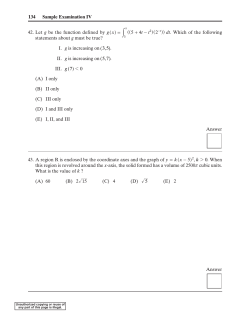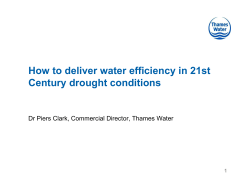
CONCEPTUAL DESIGN: AN OVERVIEW OF METHODOLOGIES, MODELS AND NOTATIONS
CONCEPTUAL DESIGN: AN OVERVIEW OF METHODOLOGIES, MODELS AND NOTATIONS 97 IDS-406/697 IDS-306/695 SYSTEMS DEVELOPMENT LIFE CYCLE (SDLC) Planning & Feasibility Study (optional) Analysis - Requirements Determination Design - Conceptual & Physical Construction (Purchase) & Testing Implementation including Training & Conversion Evolution - Maintenance & Enhancements 98 METHODOLOGY OVERVIEW Methodology defined: The way something gets done. (i.e., The strategy, steps, directions, or actions.) Methodologies can be: purchased created combination of both Thousands available for developing software-intensive information systems 99 SDLC versus Methodology SDLC = “Generic Way” Methodology = “Specific Ways” M #1 M #2… 100 METHODOLOGY OVERVIEW Classifications of Methodologies Traditional Structured Analysis and Design Information Modeling/Engineering Object-Oriented Prototyping is a technique - (some say that it is a methodology) 101 The Traditional Methodology (1950s - now) Applicable for small teams on small projects Functional perspective of a problem domain It is an informal, unstructured, unrepeatable, un-measurable, ad-hoc way 102 Traditional Methodology Tools -----------TECHNIQUES & TOOLS REPRESENTING----------System Data Process Flows Logic _ System Flowcharts Forms, Layouts, English Narrative, Playscript, Program Flowcharts, Grid Charts HIPO Charts 103 Structured Analysis and Design Methodology (mid-1970s - now) Data Flow methodology (synonym) Compliments Structured Programming Very popular - perhaps the leading one for business Can be repeatable, measurable, & automated IDE & CASE s/w tools brought significant assistance 1) Yourdon, and 2) Gane & Sarson Functional perspective of a problem domain Describes the real world as data flowing through the information system, being transformed from inputs to outputs 104 Structured Analysis and Design Methodology Tools -----------TECHNIQUES & TOOLS REPRESENTING----------System Data Process Flows Logic _ Data Flow Data Dictionary, Decision Tree/Table, Diagram Data Structure Structured English, Diagrams, Structure Charts, EntityRelationship Warnier/Orr Diagram Diagrams 105 New or Modified Monthly Statement (adapted from Systems Analysis and Design Methods, 4th Edition, Whitten and Bentley, McGraw-Hill, 1998) Monthly Statement Bank Monthly Account Statements Prior Monthly Statement Reconcile Account Balances Transaction Bill Creditor Payment Account Balance Current Balance Pay a Bill Account Transactions Bank Accounts Modified Balance Payment Account Transactions Deposit Modified Balance Withdraw Funds from an Account Withdraw or transfer Employer Pay Deposit Funds into an Account Bank Other Income Source Reimbursement (adapted from Systems Analysis and Design Methods, 4th Edition, Whitten and Bentley, McGraw-Hill, 1998) CUSTOMER Customer Number (PK) Customer Name Shipping Address Billing Address Balance Due ORDER has placed Order Number (PK) Order Date Order Total Cost Customer Number (FK) sold ORDERED PRODUCT INVENTORY PRODUCT Product Number (PK) Product Name Product Unit of Measure Product Unit Price sold as Ordered Product ID (PK) . Order Number (FK) . Product Number (FK) Quantity Ordered Unit Price at Time of Order Information Modeling Methodology (early-1980s - now) Data modeling & information engineering (synonyms) Describes the real world by its data, the data’s attributes, and the data relationships Can be repeatable, measurable, and automated Data perspective of the problem domain 108 Information Modeling Methodology Tools -----------TECHNIQUES & TOOLS REPRESENTING----------System Data Process Flows Logic _ Business Business Area Area Analysis, Analysis, Process Entity- Model Relationship Business Systems Design Diagrams 109 Object-Oriented Methodology (mid/late-1980s - now) Object modeling Compliments object-oriented programming Can be repeatable, measurable, & automated Object perspective of the problem domain Describes the real world by its objects, the attributes, operations, and relationships Data & functions are encapsulated together 110 Object-Oriented Methodology Tools -----------TECHNIQUES & TOOLS REPRESENTING----------System Data Process Flows Logic _ Object Object Model Static & Dynamic UML Model Attributes Model Diagrams, Operations, Class relationships, Object associations 111 Object-Oriented Methodology Revolutionary or Evolutionary? Most difficult aspect is the transition some people have to make from a functional or data problem solving strategy to an object problem solving strategy. Some people must change from a “function think” or “data think” to an “object think” strategy. 112 Rational Corporation’s Rational Unified Process (RUP) 113 Object Technology Principles Common Methods of Organization Abstraction Encapsulation (Information Hiding) Inheritance Polymorphism Message Communication Associations Reuse 114 O-O Systems Analysis & Design Methodology Classification Theory (Common Methods of Organization) Objects and their characteristics Wholes and Parts Groups (Classes) and Members 115 • Common Methods of Organization People are accustomed to thinking in terms of... Objects & Attributes • color • price • weight • engine • options... Wholes and Parts Groups & Members VANS: • light utility • utility • passenger • etc... • number of doors • number of wheels • number of windows • number of lights • number of bolt type 1 • number of bolt type 2 • etc.... 116 • Abstraction A mental ability that permits people to view real-world problem domains with varying degrees of detail depending on the current context of the problem. • Helps people to think about what they are doing 117 • Functional and Data abstraction • Encapsulation (Information Hiding) A technique in which data are packaged together with their corresponding procedures. In Object-Oriented Technology the “package” is called an OBJECT The interface to each object is defined in such a way as to reveal as little as possible about its inner workings Encapsulation allows [software] changes to be reliably made with limited effort [Gannon, Hamlet, & Mills, 1987] One cake please! Ingredients cake 2 eggs 4 cups flour 1 cup milk 1 cup sugar etc....... Directions Pre-heat oven to 350; Put milk, eggs, and sugar in 2 quart mixing bowl... 118 • Inheritance A mechanism for expressing similarity between things thus simplifying their definition. Inheritance Student • looks • behavior • attitudes • etc... Person Faculty Staff 119 • Polymorphism (“many forms”) The ability to hide different implementations behind a common interface. The ability for two or more objects to respond to the same request, each in its own way. H2O = water, ice, steam (liquid, solid, vapor) Eating Carbon compound crystallizes as graphite & diamond Door #1 Door #2 Door #3 versus Door #1 #2 #3 120 • Polymorphism PRINT Two examples TEXT object 25000 PRINT BLUE SKY AIRLINES Sales Report January 20000 15000 GRAPH object 10000 5000 East West North PRINT South 0 BLUE SKY AIRLINES Sales Report February IMAGE object Object #1 Add PO object Object #2 Add Account object Object #3 Add Department object = add a line item to the PO = increase $ Amount Balance = hire a new employee • Message Communication Objects communicate via messages OBJECT OBJECT OBJECT OBJECT 122 • Associations The union or connection of ideas or things. (Objects need to interact with each other) • same point in time • under similar circumstances Advertisement #2 Advertisement #1 crime scene #2 crime scene #1 Billing Statement crime scene #n Person Student Faculty Staff 123 • Reuse The ability to reuse objects Varying Degrees of Reuse: • complete or sharing • copy, purchase or cloning • partial or adjusting Software: • “Chips” • Components • Controls • Models • none 124 • Reuse Software Reuse Costs and Payoffs Orenstein, D. “Code reuse: Reality doesn’t match promise”, Computerworld, August 24, 1998, page 8. • Components must be reused three to five times before the costs of creating and supporting them are recovered • It costs one and a half to three times as much to create and support a single reusable component as to create a component for just one use • It costs 25% as much to use a reusable component as it does to create a new one • It takes two to three product cycles (about three years) before the benefits of reuse become significant 125 O-O Systems Analysis & Design Methodology Three Classic Systems Analysis and Design Challenges: Data Model versus Function Model Analysis to Design Transition Maintaining Source Code 126 Function Models User Interaction (Behavior) North Rim of the Grand Canyon Data Models South Rim of the Grand Canyon Colorado River VVVVVVVVVVVV Classic Software Development Challenge #1: Multiple Models Design Models Analysis Models North Rim of the Grand Canyon South Rim of the Grand Canyon Colorado River VVVVVVVVVVVV Classic Software Development Challenge #2: Model Transformation Who wrote this code? Begin “Caller” Program Init x,y,z... Open (files/database) Read... Compute... DO “Callee” with x,y,z Spaghetti? Update (files/database) Close (files/database) End Main Program Procedure Callee Parameters x,y,z Compute... End Procedure End Program Classic Software Development Challenge #3: Maintaining Source Code SOLUTION INTEGRATED MODEL(S) (function, data, behavior) (analysis, design and implementation) ROUND-TRIP ENGINEERING Object Technology Colorado River 130 O-O Systems Analysis Methodology A Simplified Object-Oriented Systems Analysis Methodology 131 A Simplified Object-Oriented Systems Analysis Methodology Activities 1. Identify the information system’s purpose 2. Identify the information system’s actors and features 3. Identify Use Cases and create a Use Case Diagram 4. Identify Objects and their Classes and create a Class Diagram 5. Create Interaction/Scenario Diagrams 6. Create Detail Logic for Operations 7. Repeat activities 1-6 as required to refine the “blueprints” Software Development’s “Separation of Concerns” Information System Human Interaction Problem Domain Data Management System Interaction O-O Systems Analysis Methodology The Unified Modeling Language (UML) Models and Notation 134 Subject Matter Expert & Notation Can you draw a stick figure of a person? Can you draw a picture of an automobile? Can you draw a picture of the space shuttle? Can you draw a picture of an Oopsla? Why not? Subject Matter Expert (SME) Notation - symbols used to communicate 135 “The 3 Amigos” Booch Jacobson Rumbaugh 136 Information Systems Development People Process Technology (UML - notation & tools to use it) 137 www.omg.org Version 1.1 of the UML was adopted as an OMG Standard on November 14, 1997 The Object Management Group (OMG), formed in 1989, is a consortium of about 800 software vendors, consultants and end user organizations whose mission is to develop STANDARD interfaces for INTEROPERABLE software components in HETEROGENEOUS computing environments. The OMG Revision Task Force released UML Version 1.3 in the Fall of 1998 138 The 9 Diagrams of the UML Static Class Object Use-Case Interaction/Scenario Diagrams: – Sequence Behavior Implementation (Static) – Collaboration State [-Transition] Activity Component Deployment A Package is used for Model Management U M L D i a g r a m s 140 141 142 143 144 145 146 147 “The Big Picture” A Video Store UML Class Diagram 148 149 150 151 152 153 End of “The Big Picture” QUITTING TIME 154
© Copyright 2025





















